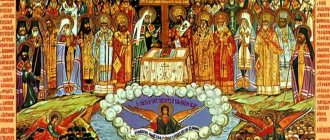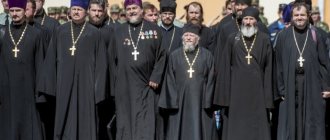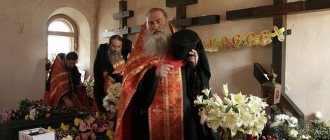Old Believers today
In recent years, an increasing number of our fellow citizens have become interested in issues of a healthy lifestyle, environmentally friendly farming methods, survival in extreme conditions, the ability to live in harmony with nature, and spiritual improvement. In this regard, many turn to the thousand-year experience of our ancestors, who managed to develop the vast territories of present-day Russia and created agricultural, trade and military outposts in all remote corners of our Motherland.
Last but not least, in this case we are talking about the Old Believers - people who at one time settled not only the territories of the Russian Empire, but also brought the Russian language, Russian culture and Russian faith to the banks of the Nile, to the jungles of Bolivia, the wastelands of Australia and to the snow-capped hills of Alaska . The experience of the Old Believers is truly unique : they were able to preserve their religious and cultural identity in the most difficult natural and political conditions and not lose their language and customs. It is no coincidence that the famous hermit Agafya Lykova from the Lykov family of Old Believers is so well known all over the world.
not much is known about the Old Believers Some people believe that Old Believers are people with a primitive education who adhere to outdated farming methods. Others think that Old Believers are people who profess paganism and worship the ancient Russian gods - Perun, Veles, Dazhdbog and others. Still others ask the question: if there are Old Believers, then there must be some kind of old faith? Read the answer to these and other questions regarding Old Believers in our article.
Old Believers - who are they?
Old Belief arose in the 17th century as a protest against changes in old church customs and traditions. A schism began after the reforms of Patriarch Nikon, who introduced innovations in church books and church structure. All who did not accept the changes and advocated for the preservation of old traditions were anathematized and persecuted.
The large community of Old Believers soon split into separate branches that did not recognize the sacraments and traditions of the Orthodox Church and often had different views on the faith.
Avoiding persecution, the Old Believers fled to uninhabited places, settling in the North of Russia, the Volga region, Siberia, settling in Turkey, Romania, Poland, China, reaching Bolivia and even Australia.
Fact 4
Faith is the formative basis of the community. The community meets regularly not in a store or a pub, but in prayer. The festive Easter service, for example, lasts from 12 midnight to 9 am. Uncle Vanya, who came from Easter prayers in the morning, says: “My bones are aching, and, of course, it’s difficult to stand all night. But now there is such grace in the soul, so much strength... it’s impossible to convey.” His blue eyes sparkle and burn with life.
I imagined myself after such an event and realized that I would have fallen and slept for another three days. And Uncle Vanya has the following service today: from two to nine in the morning. A regular service is one that lasts from three to nine in the morning. It is held regularly, every week. “Without a priest,” as Uncle Vanya says. “Everyone participates with us: everyone reads and sings,” adds Annushka.
What is the difference from the modern church, to put it briefly: there the management of the people is centralized, even at the spiritual level (which the king and the patriarch decided would reach the very bottom of the people). And with us, everyone expresses their opinion. And no one will force me. This should convince me, I should need it. Any issues are resolved conciliarly, and not centrally. All other differences are trifles and particulars that distract and deceive people,” notes Ivan.
Here's how. Whatever I read about the Old Believers, practically nothing is said about this. Modestly keeping silent about the main thing: people make decisions themselves, and not the church for them. This is their main difference!
Customs and traditions of the Old Believers
The current way of life of the Old Believers is practically no different from the one that their grandfathers and great-grandfathers used several centuries ago. In such families, history and traditions are respected, passed down from generation to generation. Children are taught to respect their parents, brought up in strictness and obedience, so that in the future they become a reliable support.
From a very early age, sons and daughters are taught to work, which is held in high esteem by the Old Believers. They have to work a lot: Old Believers try not to buy food in the store, so they grow vegetables and fruits in their gardens, keep livestock in perfect cleanliness, and do a lot of things for the house with their own hands.
They do not like to talk about their lives to strangers, and even have separate dishes for those who come into the community “from the outside.”
To clean the house, use only clean water from a blessed well or spring. The bathhouse is considered an unclean place, so the cross must be removed before the procedure, and when they enter the house after the steam room, they must wash themselves with clean water.
Old Believers pay great attention to the sacrament of baptism. They try to baptize the baby within a few days after his birth. The name is chosen strictly according to the calendar, and for a boy - within eight days after birth, and for a girl - within eight days before and after birth.
All attributes used in baptism are kept in running water for some time so that they become clean. Parents are not allowed to attend christenings. If mom or dad witnesses the ceremony, then this is a bad sign that threatens divorce.
As for wedding traditions, relatives up to the eighth generation and relatives “on the cross” do not have the right to walk down the aisle. There are no weddings on Tuesday and Thursday. After marriage, a woman constantly wears a shashmura headdress; appearing in public without it is considered a great sin.
Old Believers do not wear mourning. According to customs, the body of the deceased is washed not by relatives, but by people chosen by the community: a man is washed by a man, a woman by a woman. The body is placed in a wooden coffin with shavings at the bottom. Instead of a lid there is a sheet. At funerals, the deceased is not remembered with alcohol, and his belongings are distributed to the needy as alms.
Families
Traditionally, there is no such thing as divorce - a family is created for life, and therefore the Old Believers approach the selection of a life partner very carefully. Families , as a rule, have many children (three or more).
The spirit of mutual assistance reigns in the villages of Old Believers. It is considered the norm for the whole world to come together and help a young family build a house. And tomorrow they will also help someone.
What kind of cross do the Old Believers have?
In church rituals and services, Old Believers use an eight-pointed cross, on which there is no image of the Crucifixion. In addition to the horizontal crossbar, there are two more on the symbol.
The top one depicts a tablet on the cross where Jesus Christ was crucified, the bottom one implies a kind of “scale” that measures human sins.
How Old Believers are baptized
In Orthodoxy, it is customary to make the sign of the cross with three fingers—three fingers, symbolizing the unity of the Holy Trinity.
Old Believers cross themselves with two fingers, as was customary in Rus', saying “Alleluia” twice and adding “Glory to Thee, God.”
For worship they dress in special clothes: men put on a shirt or blouse, women wear a sundress and a scarf. During the service, Old Believers cross their arms over their chests as a sign of humility before the Almighty and bow to the ground.
Where are the settlements of the Old Believers?
In addition to those who remained in Russia after Nikon’s reforms, Old Believers who have lived for a long time in exile outside its borders continue to return to the country. They, as before, honor their traditions, raise livestock, cultivate the land, and raise children.
Many people took advantage of the resettlement program to the Far East, where there is a lot of fertile land and there is an opportunity to build a strong economy. Several years ago, thanks to the same voluntary resettlement program, Old Believers from South America returned to Primorye.
In Siberia and the Urals there are villages where Old Believer communities are firmly established. There are many places on the map of Russia where the Old Believers flourish.
Without repentance
“Oh, poor Rus', for some reason you wanted Latin customs and German actions...” These words belong to Archpriest Avvakum, who will then be burned alive as an ideologist of the Old Believers.
The textbooks don't talk about this. But the subsequent Russian riots, which shook all of Russia, were imbued not only with turmoil, but also with Old Believer ideology. And their leaders themselves - Stepan Razin, Kondraty Bulavin, Emelyan Pugachev - were Old Believers. There has never been such a confrontation between the people and the government before.
A fact almost unknown, but in Soviet times, in 1971, the Russian Orthodox Church at the Local Council of Fr. That is, historical justice was restored: Russian ancient manuscripts were recognized as correct and acceptable. The price of belated rehabilitation is hundreds of thousands of ruined and distorted destinies.
Now it is no longer reprehensible to be baptized both “in the new way” and “in the old way.” Like walking in a religious procession: with the sun and against it. It can be done this way or that way. Only the Old Believers themselves, after the cancellation of the oaths, did not cease to be considered schismatics, because “they did not show the necessary meekness in their time.”
It is no coincidence that Solzhenitsyn exclaimed in his “Red Wheel”: “God, how could we trample the best part of our tribe? How could their chapels be destroyed, while they themselves could calmly pray and be in harmony with the Lord? Cut off their tongues and ears! And still not admit your guilt?”
You just can’t idealize the Old Believers, as some modern researchers do. In past clashes, so much blood was shed on both sides that there are those to blame. And the right ones can no longer be found. Moreover, there is also no unity in the dozens of Old Believer interpretations and “agreements” that exist today. During the period of centuries-old persecutions, many of them made compromises with the authorities, and each interpreted his own correctness of serving God.
Why were the Old Believers called Bespopovtsy?
The split of the Old Believers formed two separate branches - priesthood and non-priesthood. Unlike the Old Believers-Priests, who after the schism recognized the church hierarchy and all the sacraments, the Old Believers-Priestless began to deny the priesthood in all its manifestations and recognized only two sacraments - Baptism and Confession.
There are Old Believer movements that also do not deny the sacrament of Marriage. According to the Bespopovites, the Antichrist has reigned in the world, and all modern clergy is a heresy that is of no use.
Fact 2
Despite the fact that they live on the land, their earnings exceed those of city dwellers.
The city people there are much more tense than I am here,” says Uncle Vanya. - I work for my own pleasure.
In the settlement, almost every Old Believer has a Toyota Land Cruiser in their yard, a spacious wooden house, from 150 square meters for each adult family member, land, vegetable gardens, equipment, livestock, supplies and supplies... They talk in terms of millions: “On one apiary I raised 2.5 million rubles,” Uncle Vanya confesses. “We don’t need anything, we’ll buy everything we need. But how much do we need here? In the city, everything you earn goes towards food, but here we grow it ourselves.”
“The family of my niece came here from Bolivia, sold equipment and land there, and brought with them 1.5 million dollars. They are farmers. We bought 800 hectares of arable land in the Primorsky Territory. Now he lives there. Everyone is happy, everyone lives in abundance,” continues Uncle Vanya. After this, you think: is our urban civilization really that advanced?
How do Old Believers differ from Orthodox Christians?
The main difference is this:
- Orthodox believers recognize the church rites and sacraments of the Orthodox Church and believe in its teachings. Old Believers consider the old pre-reform texts of the Holy Books to be true, without recognizing the changes made.
- Old Believers wear eight-pointed crosses with the inscription “King of Glory”, there is no image of the Crucifixion on them, they cross themselves with two fingers, and bow to the ground. In Orthodoxy, three-fingered crosses are accepted, crosses have four and six ends, and people generally bow at the waist.
- The Orthodox rosary consists of 33 beads; the Old Believers use the so-called lestovki, consisting of 109 knots.
- Old Believers baptize people three times, completely immersing them in water. In Orthodoxy, a person is doused with water and partially immersed.
- In Orthodoxy, the name “Jesus” is written with a double vowel “and”; Old Believers are faithful to tradition and write it as “Isus”.
- There are more than ten different readings in the Creed of the Orthodox and Old Believers.
- Old Believers prefer copper and tin icons to wooden ones.
Church schism
By the mid-17th century, the Russian Church came to understand the need for church reform to minimize the differences between the Greek and Russian traditions.
Tsar Alexei Mikhailovich appointed Metropolitan Nikon of Novgorod in 1652, after the death of the previous head of the church.
Nikon, who had already served in the church for a long time, had his own view of the texts and rituals. The Patriarch believed that it was necessary to carry out church rites as accurately as possible , since this is of key importance. The Church of Constantinople was considered a model in this matter; having taken the highest position, Nikon decided to implement his ideas and carry out church reform.
It is noteworthy that Patriarch Paisios of Constantinople, with whom Nikon consulted, noted that rituals are an insignificant part of religion; they can be interpreted and performed in different ways. Nikon took the answer in his own way. Therefore, in the 1650s, the reform of Russian church traditions began with the support of Tsar Alexei Mikhailovich Romanov.










